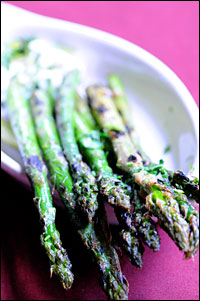Asparagus may be associated with spring, but there’s nothing new about it. It’s been gracing tables — to the joy of some diners and the horror of others — for at least two thousand years. In the earliest known cookbook, De Re Culinaria (circa A.D. 100), proto-foodie Marcus Apicius recommends pounding asparagus tips with black pepper, lovage, coriander, savory, onion, wine, oil (presumably from olives), eggs, and a kind of fermented, fish-flavored sauce — all then to be baked, then seasoned with more pepper.

Look who’s stalking.
Photo: Kurt Friese
Sounds like a sort of dip, ancient Rome’s answer to hummus. I’ll have to experiment with it sometime.
From there, though, its history becomes murky. Culinary etymologists cannot find a source for its name. Records show it popping up in England in the 1500s, but no one knows how long it was there, or where it came from. Evidence of it turns up in France 100 years later, but no one knows how it got there, either. A similar situation hangs over its introduction to the New World. In all these cases, its seeds might simply have been propagated by birds.
Rather than puzzle over its origins, most of its fans prefer merely to eat it — craving it strongly soon after winter breaks. While some of my friends in warmer climes are already snipping their first tender stalks, we are still a month away from seeing ours here in Iowa. We’re hoping for a bumper crop: The rain-sun-rain-sun pattern we’ve had so far this spring provides ideal conditions for my favorite wild foods, including ramps, fiddleheads, morels, and asparagus — which is essentially a weed in these parts.
At my restaurant, we recently brought out the new spring menu, which includes our very popular grilled asparagus. We can’t source it locally just yet, but by the time the first crocuses pop up around here, the clients clamor for their fix of said grilled asparagus with aioli. In the weeks before we harvest the first stalks in Iowa, we source organic asparagus from (gasp) California and Florida. While I would dearly prefer to provide solely local produce for my patrons, we are realists and this is Iowa. Meat and dairy I can get locally year-round; the green stuff, not so much. More and more hothouses are popping up, so maybe someday I will be able to source locally year-round.
My own crop will be along soon enough. With any luck, we’ll have enough of a bounty to devote some to cultivating the prized, milder white asparagus, which you achieve simply by not allowing chlorophyll to develop. We do this by shielding the sprouts from light using opaque plastic tunnels or boxes. If you like traditional techniques, just keep burying the sprouts as they grow toward the sun, then dig them back out.
Whether you grow it yourself, pick up the wonderful stuff at the local farmers market, or forage for Iowa’s abundant wild asparagus, one surefire way to convert even the most reluctant asparagus eater is this simple method for grilled asparagus.
Easy Grilled Asparagus
4 tablespoons extra virgin olive oil
1 tablespoon minced fresh garlic
1/4 cup fresh chopped blend of your favorite herbs, such as basil, thyme, rosemary, tarragon, or parsley
Salt and fresh cracked black pepper to taste
Soak the asparagus in cold saltwater for half an hour, then rinse and pat dry. Coat with the oil, then toss with the garlic, herbs, salt and pepper. Refrigerate 1 hour to overnight.
Preheat grill to high temperature, then lay the spears in a flat row, crossways on the grate. Allow to char lightly (1-2 minutes), then turn and do the same on the other side.
Serve immediately with aioli or vinaigrette. Serves 4.


